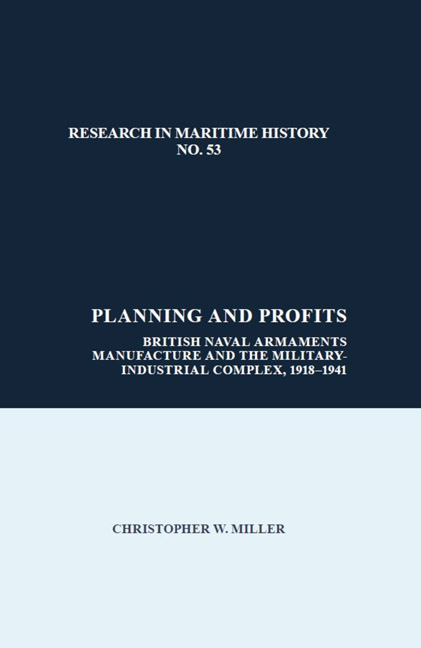 Planning and Profits
Planning and Profits Book contents
- Frontmatter
- Contents
- Acknowledgements
- About the Author
- List of Tables and Figures
- List of Illustrations
- List of Abbreviations
- A Note on Definitions
- Part One Introduction
- Part Two Industry and the Navy before Manchuria, and the Establishment of the Warshipbuilders’ Committee, 1919–1931
- Part Three The Formation of a National Government, the Far East, and the PSOC Approach to Industry, 1931–1934
- Part Four The Ultimate Potential Enemy and Rearmament Planning, 1934–1936
- Part Five The Inskip Era and War, 1936–1941
- Conclusion and Retrospective
- Appendices
- Bibliography
- Index
Conclusion and Retrospective
- Frontmatter
- Contents
- Acknowledgements
- About the Author
- List of Tables and Figures
- List of Illustrations
- List of Abbreviations
- A Note on Definitions
- Part One Introduction
- Part Two Industry and the Navy before Manchuria, and the Establishment of the Warshipbuilders’ Committee, 1919–1931
- Part Three The Formation of a National Government, the Far East, and the PSOC Approach to Industry, 1931–1934
- Part Four The Ultimate Potential Enemy and Rearmament Planning, 1934–1936
- Part Five The Inskip Era and War, 1936–1941
- Conclusion and Retrospective
- Appendices
- Bibliography
- Index
Summary
While events after 1939 lie, in the main, outside the remit of this book, the general questions throughout have been to consider the role of industrialists and the private naval arms industry within supply planning, and to assess how they influenced, and were affected by, government policy. More generally, it has sought to examine decision-making processes and the effectiveness of the supply planning machinery in the CID and related bodies throughout their development in the 1920s and 1930s. Therefore, the early phase of the war and the culmination of years of planning and organising (and price-fixing) serve as the best place to conclude this work, rather than the outbreak of war itself.
Bearing this in mind: there are some overarching points to be made. The first concerns the role of an industrial elite within the state. This book has shown that in the case of naval arms there was both an elite group of “insiders” and a defensive ring of “outsiders” before 1936. There was no “web” of well-connected individuals conspiring with government to profit from the standard kind of “Military-Industrial Complex” that subsequent theories have sought to find. In the 1920s, the Admiralty and private industry certainly shared interests in the preservation of capacity, and as such jointly devised methods to protect facilities as best they could in the circumstances. This was, however, the result of a lack of power and influence, not evidence of it. At any rate, the schemes were small-scale and extended no further than a work-sharing rota or minor subsidies. Indeed, before Manchuria in 1931, the Admiralty struggled to articulate the need for more or newer vessels in the face of Treasury opposition, leading to the decline of the Royal Navy as an effective global fighting force and to the unquestionable decline of private manufacturing capability.
In the case of the “insiders,” their story was in some ways not unlike the 1920s Admiralty-industry relationship that brought about the WSBC. Again, it was not a vast shadowy network of industrialists influencing state decision making. The Supply Board turned to a handful of tried and trusted individuals, names which appeared and re-appeared in a variety of situations between 1920 and 1940.
- Type
- Chapter
- Information
- Planning and ProfitsBritish Naval Armaments Manufacture and the Military-Industrial Complex, 1918–1941, pp. 217 - 223Publisher: Liverpool University PressPrint publication year: 2018
